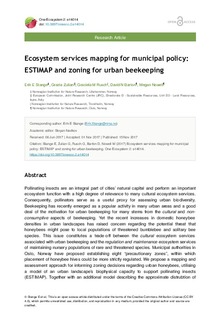Ecosystem services mapping for municipal policy: ESTIMAP and zoning for urban beekeeping
Journal article
Published version

Åpne
Permanent lenke
http://hdl.handle.net/11250/2469554Utgivelsesdato
2017Metadata
Vis full innførselSamlinger
- Publikasjoner fra CRIStin - NINA [2364]
- Scientific publications [1392]
Originalversjon
10.3897/oneeco.2.e14014Sammendrag
Pollinating insects are an integral part of cities’ natural capital and perform an important ecosystem function with a high degree of relevance to many cultural ecosystem services. Consequently, pollinators serve as a useful proxy for assessing urban biodiversity. Beekeeping has recently emerged as a popular activity in many urban areas and a good deal of the motivation for urban beekeeping for many stems from the cultural and nonconsumptive aspects of beekeeping. Yet the recent increases in domestic honeybee densities in urban landscapes has raised concern regarding the potential threat that honeybees might pose to local populations of threatened bumblebee and solitary bee species. This issue constitutes a trade-off between the cultural ecosystem services associated with urban beekeeping and the regulation and maintenance ecosystem services of maintaining nursery populations of rare and threatened species. Municipal authorities in Oslo, Norway have proposed establishing eight “precautionary zones”, within which placement of honeybee hives could be more strictly regulated. We propose a mapping and assessment approach for informing zoning decisions regarding urban honeybees, utilising a model of an urban landscape’s biophysical capacity to support pollinating insects (ESTIMAP). Together with an additional model describing the approximate distrubtion of honeybees in Oslo, we identify areas in the city where domestic honeybees may be more likely to exhaust floral resources. This case also tests the policy relevance of ecosystem service mapping tools beyond awareness raising, with broader general lessons for ecosystem mapping and assessment. Keywords Ecosystem services, Pollination, Honeybees, Wild bees, Urban, Mapping, Trade-offs
